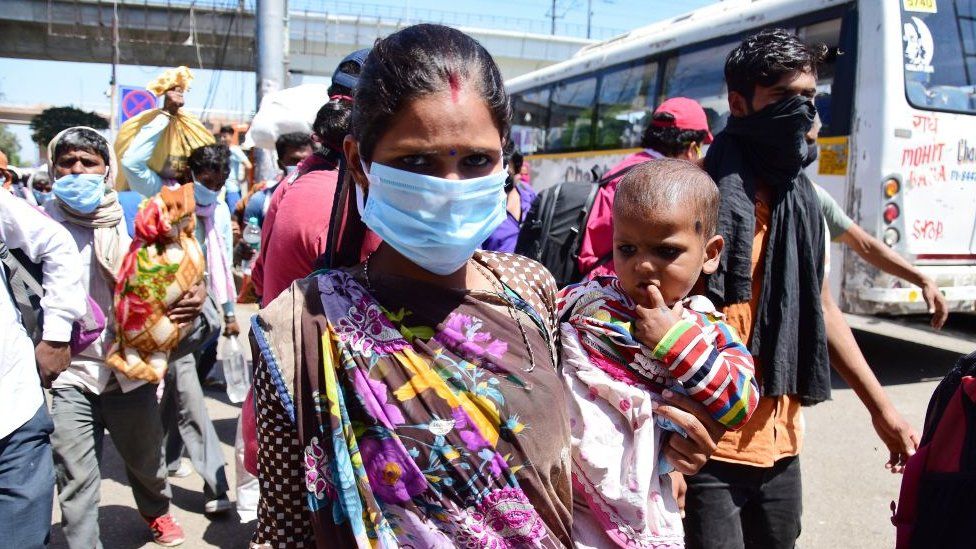A recent New Yorker article analyzed that, “one in three jobs held by women has been designated as essential work” in the United States. At the same time, the work they are engaged in is both underpaid and undervalued. During this pandemic, number of women exceeds men in the workforce contrary to normal times in the US. This is because a significant percentage of the workforce is engaged in paid care work, whose efforts are pivotal in course of this pandemic. The paid care work as social and health workers is a denominator that underscores women’s work across time periods and geographies. In India, women have historically been employed in five sectors, namely, agriculture, health, education, paid domestic work and manufacturing. Nearly 80 percent of female workforce is working in these five sectors. However, 63 per cent of the female workforce is engaged in agriculture.
Following the COVID-19 lockdown, most paid care work services within the household has been suspended, shifting the burden of the household work on the women and young girls.
Women In The Indian Labour Market
Given this status of female workers who constitute a mere 23 percent of the total employment (PLFS 2017-18) how will the female workforce fare during and after the pandemic, given what we already know?
The pandemic, even though, is a completely new paradigm, does not preclude the social-economic inequalities that prevailed prior to its onset. This has now been layered with India’s universal lockdown and physical distancing as guidelines and measures to combat the spread of COVID-19. While the necessity of these measures cannot be debated, a blanket and universal imposition without a charter of measures to mitigate differential outcomes is outright discriminatory.
The measures to combat COVID-19 overlooked the wide spectrum of substantive location of gender, class, caste and religious faith. Citizens’ ability to abide by these guidelines is contingent on access to food, water, sanitation, healthcare, and social security schemes for survival without having to leave home to work. Devoid of this, the measures protects only a few ‘while collared’ workers, thereby casting a long shadow of pain, poverty, malnutrition, and health complications on the lives of many more who sustain themselves hand to mouth.
Consider the case of women workers in these five sectors mentioned above. A vast majority of women in manufacturing and agriculture are self-employed while most men are regular workers. The implication of self-employed nature of work is that workers may be working at home, and with flexible work hours. However, this means the burden of household and care remains with women without any tangible redistribution. The lockdown has cut-off all means of sourcing such work and hence, the income earned. This will then cascade further in the form of undernourishment and psychological stress of members of the household, especially women with increased demands on their time.
A lot of evidence points to the extension of gender norms that attribute care roles to women in the domestic sphere, into the economic sphere as well. With state being a party to the acceptance of these norms, it is not surprizing that a higher proportion of women in the economy will suffer from the social and economic impacts of COVID-19.
Similar precarities shadow the livelihoods of paid domestic workers, who are mostly migrant workers in urban centers. These workers are excluded from nearly all basic essential working conditions—paid annual leave, medical leave, working time, minimum wage coverage and social security. Post the announcement of complete lockdown in India, domestic workers whose inflow of income is solely dependent on their individual employers find themselves stranded and reliant on their employers’ goodwill.
These outcomes are predictable because women working in these sectors often make a distress-driven choice to work. There is also a need to consider the loss of employment for women headed households (often widowed or divorced/separated women) whose work participation exceeds that of currently married or unmarried women (in the age group of 15-60 years of age) implying their higher livelihoods needs.
A higher percentage of women employed in health and education sectors have regular (88 percent and 90 per cent respectively) and public sector jobs (44 percent and 57 per cent respectively) which safeguards their employment and economic benefits, to an extent, during the lockdown. The health workers are undoubtedly working at a higher personal risk providing care and treatment to thousands affected by the pandemic. However, the skewed gendered ratio of frontline caregivers and nurses, plus the lack of personal protective equipment heightens their vulnerability to sickness.
A lot of evidence points to the extension of gender norms that attributes care roles to women in the domestic sphere, into the economic sphere as well. With state being a party to the acceptance of these norms, it is not surprising that a higher proportion of women in the economy will suffer from the social and economic impacts of COVID-19.
The pandemic is not gendered, but the state’s response to it is. While it is hard to craft emergency response that is gender sensitive if the foundational structures are built insensitively, it is concerning to see little or no policy reflection on this as the situation extends.
Anticipated Burdens
The pandemic is not gendered, but the state’s response to it is. While it is hard to craft emergency response that is gender sensitive if the foundational structures are built insensitively, it is concerning to see little or no policy reflection on this as the situation extends. The pandemic has disrupted the normal and caused a meltdown that we are unable to grasp. Nonetheless, it can be argued that the configuration of the normal itself was highly problematic, specifically, with regards to the labour market and the political economy of care.
At this point, it must be emphasized that socio-historical response to pandemics brings into light the nexus between socially constructed moral obligations of care and well-being of the society. This obligation is not only fulfilled by the women workforce who are professionally trained to practice it but extends beyond the boundaries of paid work.
This lockdown demands for home be a haven with beefed up cleanliness standards, hygiene discipline and provide for basic provision like food and water for its members. When state delegates a set of duties to its citizens which must and can be fulfilled within the perimeters of the household alone, it essentially descends on the women of the household including young and adolescent girls to fulfill it. The current delegation of care responsibilities results from historical, social, and cultural framework of ‘male breadwinner and female caregiver’ that has been governing family, market and state ideologies over decades.
Also read: Covid-19 Pandemic & The Socio-Economic & Political Impact On Women
It is hard to imagine that few months of pandemic induced lockdown will perpetuate an equal division of domestic labour between members of households and bring a behavioural and attitudinal change amongst men. If there are lessons learnt from the previous pandemics and public health crises, it is that women’s economic independence and autonomy will bear the silent brunt, if not proactively alleviated. In past pandemics women have taken longer to return to their pre-outbreak incomes levels compared to men. In India, such trade off seems likely given the lower income earned by women or alternatively can push them into high risk trades.
A recent Lancet article points out that policies and public health efforts have not taken the gendered implications of the illness and the changing social organization despite the evidence from the past disease outbreaks. While the pandemic adds to the economic crises and is likely to lead to a long recovery period, it is important that we remain alert to multiple vulnerabilities impacting women in the economy.
As many have iterated, there are multiple lessons to from the gendered outcomes from COVID-19 and previous health crises that spans several aspects like health, economic empowerment, violence and education. In the short turn, the responses to COVID-19 must be embedded with concerns of differential outcomes, for example, adequate prevention and redressal mechanisms from law and enforcement to curb global rise in domestic violence. Government unemployment support in India must be extended to women workers who form a large proportion of the informal sector.
Also read: How Is Domestic Violence Linked To The COVID-19 Lockdown?
Similarly, in the long run as the economic activities open, it is important to return to long-standing recommendations of improving terms of employment for women with implementation of fair wages, so that women are not marginalized from working. The gender responsiveness of the states must be targeted to comprehensively enhance aspects of women’s ‘world of work’ which includes wide-ranging forms of work and workplaces.
Srishty Anand is a Senior Research Associate at ICRW, and armed with an MPhil in Sociology. She has about five years of research experience on economic empowerment and urbanism. She’s an avid listener of audiobooks and podcasts, and a gardenophile over the weekends. You can find her on Twitter, Instagram and LinkedIn.
Sharmishtha Nanda is a Technical Specialist at ICRW with a decade of experience in development research. Her work is focused on economic empowerment and sexual and reproductive health and rights for young women. She’s an aspiring mandala artist and urban gardener with about 60 pots adoring her house. You can find her on Twitter, Instagram and LinkedIn.
Featured Image Source: BBC




This post is very helpful and informative. Keep Posting such an informative post in the future